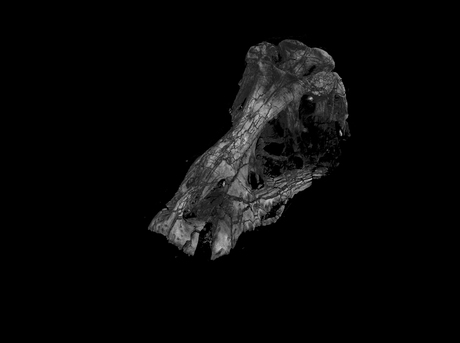Get inside the head of a T. rex

It looks like Jurassic World won’t be the only place where you can see a dinosaur this year, with recent computed tomography (CT) images revealing a look inside the head of what is arguably the world’s most famous prehistoric monster.
In 2013, researchers from the Naturalis Biodiversity Center in the Netherlands made a remarkable discovery in Montana in the United States: one of the best preserved Tyrannosaurus rex skeletons ever found. In June 2015, the Development Center for X-Ray Technology (part of the Fraunhofer Institute for Integrated Circuits IIS, Germany) presented exclusive CT images of that very T. rex’s skull.
Experts have dated the dinosaur’s remains to 66.4 million years, with its skull alone weighing 500 kg. In order to get a glimpse of the internal structures of the remains without damaging the fragile skeleton, the Fraunhofer Development Center for X-Ray Technology utilised one-of-a-kind XXL CT technology which is capable of generating high-resolution data.
The precise, cross-sectional X-rays of the skull were able to ensure the conservation and preservation of the remains. Surprises, such as hidden fractures, could be reliably detected in advance and then taken into consideration during the preparation. Furthermore, using the X-ray data and a 3D printing process, a true-to-original copy of the skeleton can be produced.
“Concealed areas are especially interesting for us,” said Dr Anne Schulp, a palaeontologist and dinosaur researcher at the Naturalis Biodiversity Center. “With this method we are in a position to reconstruct the structure of the skeleton, especially since the skull is in such excellent condition in this case.
“I’m extremely excited about the mould of the inside of the skull,” Dr Schulp continued. “We can show what the brain looked like without having to open up the irrecoverable skull.”

The remains are set to offer new knowledge about the T. rex and its habitat. According to the head of the Naturalis Biodiversity Center, Edwin van Huis, “This discovery will have an enormous impact on dinosaur research for decades to come.”
Revealed: the complex composition of Sydney's beach blobs
Scientists have made significant progress in understanding the composition of the mysterious...
Sensitive gas measurement with a new spectroscopy technique
'Free-form dual-comb spectroscopy' offers a faster, more flexible and more sensitive way...
The chemistry of Sydney's 'tar balls' explained
The arrival of hundreds of tar balls — dark, spherical, sticky blobs formed from weathered...




